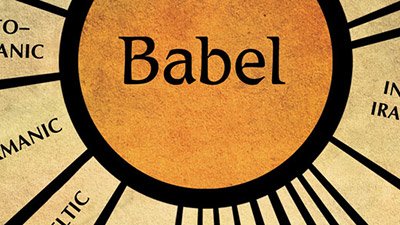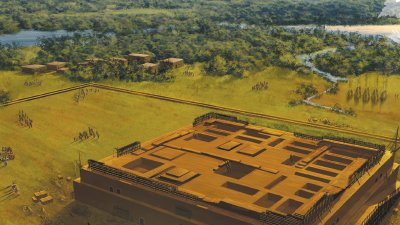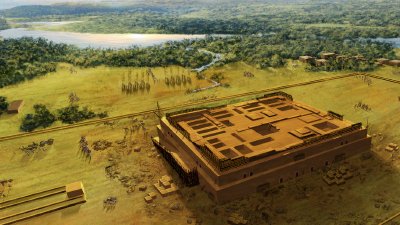Tower of Babel
The tower of Babel (2242–2206 BC) was a post-flood rebellion against God by Noah’s descendants. Though the Babel account is related in a mere nine verses (Genesis 11:1–9), the resulting judgment of this rebellion accounts for the variety of languages and people groups seen in our world today.
The Biblical Account
When God blessed Noah and his sons after the global flood, he told them to “be fruitful and multiply and fill the earth” (Genesis 9:1). But only about a century later, we see that man seems to have no interest in obeying the command to fill the earth.
Now the whole earth had one language and the same words. And as people migrated from the east, they found a plain in the land of Shinar and settled there. And they said to one another, “Come, let us make bricks, and burn them thoroughly.” And they had brick for stone, and bitumen for mortar. Then they said, “Come, let us build ourselves a city and a tower with its top in the heavens, and let us make a name for ourselves, lest we be dispersed over the face of the whole earth.” (Genesis 11:1–4)
Fueled by pride, the people preferred to “make a name” for themselves and build a city with a high tower, enabling them to remain together in defiance of God’s command. The proposed construction began. Composed of brick and mortar, this city was intended to be permanent and impressive—a fortress against any natural or supernatural attempt to disperse mankind throughout the earth.
But God was neither unaware of their actions nor powerless against their plans. In his mercy, he intervened—not by destruction as he had during the flood, nor by directly driving them out to be fugitives and wanderers (as in the record of Cain’s judgment; see Genesis 4:12). Instead, God divided their single language into multiple language families.
And the Lord came down to see the city and the tower, which the children of man had built. And the Lord said, “Behold, they are one people, and they have all one language, and this is only the beginning of what they will do. And nothing that they propose to do will now be impossible for them. Come, let us go down and there confuse their language, so that they may not understand one another’s speech.” (Genesis 11:5–7)
For the first time in earth’s history, there was a language barrier. Without a common language, the people who had been so adamant about staying together were now unable to even understand each other. Construction of the city ceased—whether because they lost interest in the city due to the futility of attempting to coordinate such a massive project without a means of communication (not to mention losing the appeal of living together as one people) or because they recognized God’s judgment and feared a worse sentence should they attempt to continue in their rebellion.
Whatever the case, God’s judgment was effective. The attempted “one-world kingdom” fractured. Smaller groups formed from those sharing each of the new languages, and people began scattering from the city.
So the Lord dispersed them from there over the face of all the earth, and they left off building the city. Therefore its name was called Babel, because there the Lord confused the language of all the earth. And from there the Lord dispersed them over the face of all the earth. (Genesis 11:8–9)
Why Does It Matter?
Besides being a fascinating part of mankind’s history, the biblical account of the events at Babel also answers some of the questions and problems of our day. It especially challenges certain evolutionary ideas and provides a reasonable explanation for the diversity in languages and people groups seen today.
Diversity of Languages
Perhaps the most obvious area explained by Babel is the origin of the various languages present in our world. While an evolutionary worldview might expect all languages to trace back to a single parent language (much like it claims all life traces back to one organism), that isn’t what researchers have found. Instead, language families of today trace back to multiple unrelated parent languages—exactly what one would predict from the Babel account.
What Basis for Racism?
The evolutionary story of man’s origins is inherently racist (because of its implications that some people groups are more evolutionarily advanced than others and, therefore, that the “lower” groups are more closely related to primates). However, the Bible’s account of the events at Babel confirms that all people are descended from the groups split at Babel (who were all direct, recent descendants of Noah and, consequently, from the first humans—Adam and Eve—who were special, direct creations of God). There is no basis for racism as all people are related and comprise only one “race” of people made in the image of God. Therefore, they are all equal and all equally human.
Physical Differences Between People Groups
But why, then, do people from various parts of the world look so different from each other? The explanation for differences in physical appearance is simple. As the groups spread out and separated from each other after Babel, their gene pools were largely isolated—generally more so, the farther apart they were—and physical features such as certain skin shades or eye shapes gradually became dominant within each group. These distinctive features are still reflected in the diversity among people groups today. But far from evidence of evolution, these minor genetic differences (and they are minor—making up only a very small percentage of an individual’s DNA) are the natural result of the loss of genetic variability that occurs when people groups are isolated from one another.
For more information related to the tower of Babel, check out these articles:
Was There a Real Tower of Babel?
There exist a great many confirmations of the Bible’s account of the tower of Babel and what happened as a result. Language changes, ziggurats, names of Noah found throughout the world, and tower legends are excellent confirmations of the events at Babel.
What Happened at the Tower of Babel?
God’s gentleness in judging the rebels at Babel is a lesson for us today. By changing one language into many, he separated nations more effectively than any Great Wall of China. God stepped in to prevent the human race from falling under the sway of a single, absolute tyrant over all the earth.
Evolution and Languages
In their efforts to explain the multitude of languages, secular theories come up empty. They are upstaged by the biblical narrative, which credits God with the gift of language and the vast diversity of different language families. The words language, tongue, speech, and word appear in the Bible at least 1,401 times.
Diversity of Languages Started at Babel
“Why do intellectually superior humans have around 7,000 distinct languages?” queries evolutionary biologist Mark Pagel. Pagel heads a team searching for an evolutionary explanation for our many languages. The biblical history of the dispersion from the tower of Babel indicates that diversity of language emerged from “a plain in the land of Shinar.”
Articles About Tower of Babel
-
Jan. 1, 2024 from Answers Magazine
Language is more than just symbols and sounds. It is a gift from God that lies beneath the reality of creation.
-
Feb. 15, 2015 from Answers Magazine
Some people think the Bible justifies their racist attitudes. Yet when we examine what the Bible says about the origin of different people groups, we find a different story.
-
Nov. 3, 2013 from Answers Magazine
Did the various families who left Babel leave any trace of their journeys?
-
Evolutionary Language Search Lands at BabelJan. 5, 2013 from News to Know
Search for evolutionary explanation of languages falls short and lands at Babel.
-
Intertwining Evolution and Linguistics Breeds ControversyNov. 26, 2011 from News to Know
Linguists lobbying against evolutionary oversimplifications refuse to yield to the authority of statistics
-
The Mother Tongue?April 23, 2011 from News to Know
Two separate linguistics studies provide findings consistent with a biblical worldview.
-
Will You Help Us Defend the Truth of God’s Word?Jan. 24, 2011 from Letter from Ken
The building of Noah’s Ark is a way to challenge people to accept the truth of God’s Word, and just as important are the other exhibits of the Ark Encounter.
-
Aug. 8, 2010 from Answers Magazine
Were people separated at Babel because God miraculously changed the common language?
-
June 13, 2010 from Answers Magazine
Nations that once feared God now ignore Him and despise His Word. Not much has changed in the lst four thousand years, since Babel.
-
How is Language Driven?Jan. 24, 2009 from News to Know
“But if universal grammar did not evolve by natural selection, how could it have arisen?” That’s one question posed by a recent study—one we can certainly answer!
-
Magazine Department ArticleBabble at BabelApril 1, 2008 from Answers Magazine
We all have communication challenges from time to time.
-
Magazine Department ArticleBabel Explains Our DifferencesApril 1, 2008 from Answers Magazine
View a chart illustrating how Babel explains our differences.
-
March 18, 2008 from Answers Magazine
The simple answer is that the Bible does not tell us. All we know is that God intervened before the construction project was completed.
-
Answers Magazine Preview: Vol. 3, No. 2March 11, 2008
The special “Tower of Babel” issue of Answers magazine covers some fascinating aspects of the Babel account as recorded in Genesis 11.
-
Magazine ArticleTongue-Twisting TalesFeb. 18, 2008 from Answers Magazine
Stories about a time when there was only one language do exist.
-
Research Supports Biblical Description of Language DevelopmentFeb. 9, 2008
New research on the “evolution” of language supports the Bible’s description of all languages having appeared recently.
-
Feedback ArticleDid People Groups form Before Babel?Oct. 13, 2006 from Feedback
What we have in Genesis 10 is a general overview of what happened, but then Genesis 11 goes into more detail of why and how the nations were divided according to their languages.
-
Magazine ArticleApes, Words, and PeopleJune 1, 2003, pp. 50–51
Many years ago a friend of mine said, in response to my biblical challenge to his theistic evolutionary ideas, ‘If God didn’t evolve us from apes, why did He make us to look so much like them?’ I didn
-
Magazine ArticleBabelJune 1, 2002, pp. 31–33
God’s judgment of the Tower of Babel was one of the greatest catastrophes in the history of the world. In one moment, a massive, highly complex building project, involving the entire human race, came
-
Magazine ArticleTalking PointMarch 1, 2001, pp. 42–45
One of the great mysteries of life is the origin of language. We use it every day to communicate with each other, but how did it begin?
-
Overcoming Babel!Sept. 7, 2000
Praise the Lord we are able to take the creation/gospel message into other languages to restore the truth they once had and preach the true history of the world.
-
Technical Research PaperThe Development of Languages is Nothing Like Biological EvolutionAug. 1, 2000, pp. 31–40
The changes that have occurred in the Indo-European language family, for example, demonstrate that languages follow a 'downhill' simplification in inflections, etc. by natural processes.
Recommended Resources

Answers in Genesis is an apologetics ministry, dedicated to helping Christians defend their faith and proclaim the good news of Jesus Christ.
- Customer Service 800.778.3390
- © 2025 Answers in Genesis











